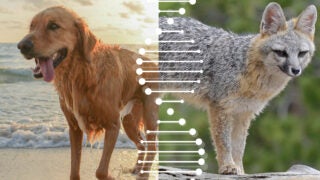Trojan Tech Talk
Anyone can come up with an idea, but an entrepreneur acts upon it and brings it to life. So what distinguishes the entrepreneurial mindset? We asked four USC alumni and faculty members from the startup world about their decisions and why they made them. Their common ground: curiosity, persistence and the embrace of calculated risks.
[flipbook anchor=”ellis” ids=”94378,94379,94380,94381,94382″]
Ellis Meng
Ellis Meng didn’t intend to become an entrepreneur – all she really wanted was to get tenure. But natural-born innovators need an outlet. Today Meng, 40, is co-founder of research micro-pump company Fluid Synchrony and is on the verge of creating a second company aimed at treating hydrocephalus, a serious, abnormal buildup of fluid in the brain.
Why did you become an entrepreneur?
I didn’t start off with any entrepreneurial leanings, but I came to realize that I needed to connect my research with real problems and real clinical applications. That pushed me to translate how my work could apply beyond academia. Once I was bitten by the entrepreneurial bug, I never looked back.
You trained as an electrical engineer, yet you invent medical devices. How did that happen?
I wasn’t a standard electrical engineer. I was adapting microfabrication techniques commonly used for integrated circuits to build microfluidic devices—in other words, to push fluids around on silicon chips. The big push was to use them for diagnostics, but I started working with clinical applications, specifically implantable devices.
What makes you a good entrepreneur?
Every time I enter into a collaboration with a new clinician in a different area, it’s like speaking Greek at first. Over time I figure out their language and they figure out mine. You have to be very nimble and adapt quickly. Communication is key: Understanding the problems that other people face requires getting out there and talking to them. Clinicians don’t know to come to you. Once I do see what problems they’re facing, I need to understand what I can and can’t do. After I define the boundaries, I understand my creative space. When I hit a dead end, I can pivot quickly to another clinical indication until I find a good fit.
What inspires you?
Progress and the potential to make an impact. I’m constantly adapting as new information is fired at me and I’m revising the best approach. Clinicians want to work with people who are passionate about helping their patients. They want fresh eyes and new ideas to address problems that haven’t been solved. My students inspire me with their fresh eyes, too. They bring up new approaches that I’ve never thought of. I can’t do everything on my own.
[flipbook anchor=”sahil” ids=”94374,94375,94376,94377″ position=”left”]
Sahil Lavingia
Sahil Lavingia was a USC Viterbi freshman when he was invited to create an iPhone app for Pinterest. Despite being employee No. 2 at a startup estimated to be worth $40 million at the time (Pinterest now has a roughly $11 billion valuation), Lavingia quit in 2011 to found social commerce startup Gumroad. He was named one of Inc. magazine’s “30 Under 30” for 2015. And did we mention that he’s 23?
Why leave Pinterest to strike out on your own?
It wasn’t the best decision financially, but if finances drove my decisions, I’d be a very different person. I had an idea to work with and I wanted to start a company myself. The idea behind Gumroad came from when I wanted to sell an icon I had designed in Photoshop. It was a tiny thing without much value, but I wanted to see whether I could put it up for sale. As it turns out, it was far more difficult than it should have been. I wanted to solve that problem and there was a business opportunity in making it easier for everyone else to sell their work.
What makes you a good entrepreneur?
I really like doing it, that’s the biggest thing. I don’t do it because I believe I’m going to make a bunch of money. I do it because I’m solving real problems. I especially like making things for people who make things. I like this meta-idea of building a product that lets people like me accomplish their goals. It’s important to me that I’m adding to the world.
What inspires you? How do you generate new ideas?
It’s hard to create a formal process for generating ideas and it’s frustrating to separate good ideas from bad ideas. Having too many ideas is the real problem. People have an inherent desire for everything they do to be good. But they forget that it takes a lot of editing and throwing out bad ideas to get all of the good stuff in the finished product.
How do you avoid falling into a rut?
Everyone falls into a rut from time to time, but good work is like motivating yourself to go for a run. The real challenge is getting started at all. The first five or 10 minutes of a run can be really difficult, but then you get into the pace of it. Ultimately, you’re a better person for having done it.
[flipbook anchor=”zach” ids=”94383,94384,94385,94408,94407,94388″]
Zach Weisberg
Zachary Weisberg MBA ‘13 originally intended to become a journalist. But after managing Surfer magazine’s digital properties for four years, he decided to pursue an MBA from the USC Marshall School of Business. The Inertia—his news site and online community for surf and snow sports enthusiasts—beat 120 other startup ideas for the top prize at USC Marshall’s New Venture Seed Competition in 2011.
Why go back to school for an MBA?
To learn the things I never would have learned on my own, or it would have taken me a very long time to learn them. What I came away with was a deeper understanding of the importance of relationships and helping each other along the way. Before school, my perspective was that of a journalist. To have a shot at building a great business, I had to adjust how I viewed the world. I had to learn how to be a great partner to our advertisers and to the brands that support us while staying true to our original vision.
What makes you a good entrepreneur?
I think I always had entrepreneurial tendencies. I had a punk rock band when I was younger, and we were selling CDs door to door until I paid off the cost of the digital recorder I used to produce the album. I guess I had entrepreneurial instincts and ambitions from a young age.
Resilience is really important. If you believe in yourself and the people around you enough then you can begin to will things to happen. Entrepreneurship requires the relentless pursuit of an idea even if it’s challenging and even if you get turned down time and again. My mom has a saying she impressed upon me: Energy and persistence conquers all.
What inspires you?
Being outdoors and active and surfing in beautiful places lends itself to all the clichéd inspirational things you might imagine. I get a lot of energy from great people. Being around positive, driven people who are making things happen while enjoying themselves along the way is always inspiring.
Of the many hats you wear, which do you enjoy most and why?
I enjoy being able to participate in all elements of the business. It’s really fun. Today I was working on a feature and helping edit a video and coordinating an ad buy and forecasting our budget—all in the same day. Oh, and interviewing to hire. Sometimes it’s overwhelming and confusing and I’m sure I could benefit from giving some of these hats away. But I do enjoy the whole mix, rather than getting bogged down in the minutiae of one particular job. I probably gravitate more toward the creative and storytelling elements of what we’re doing, although it would be hard to go back to doing only that.
[flipbook anchor=”elizabeth” ids=”95479,95480,95481,95482″ position=”left”]
Elizabeth Amini
Anti-AgingGames.com was born in 2008 after Elizabeth Amini MBA ‘08 and her friend (and Atari founder) Nolan Bushnell were joking around about the volume of useless knowledge that video games embed in a user’s brain. The company offers online memory and focus games for people 35 and older. Amini, 43, who teaches business with an emphasis on social entrepreneurship, donates 20 percent of the company’s pre-tax profits to global charities helping people and animals.
Why create your startup?
Nolan and I had a lightbulb go off when we began to wonder whether video games could improve memory. My background is in cognitive science [Amini holds a bachelor’s in the subject from Occidental College], so I already knew that brain-training exercises could possibly work, but they tended to be boring. He said he could make anything fun. We immediately started researching the science side of it because we didn’t know if it was even possible. We put together a science advisory team and reviewed 17,000 medical studies about the brain. We discovered the short answer is, yes, it’s possible. We focus now on what can actually improve real life.
What makes you a good entrepreneur?
Persistence. In my case, it comes from early childhood experiences. I was really bad at sports, but all the schools I went to required team sports every term. When you keep striking out over and over again, you get used to failing and it doesn’t bother you as much. I weaseled my way out of winter sports by helping manage the boys’ ice hockey team, so even my earliest management skills came from trying to escape sports. It’s a bit embarrassing but true.
How do you generate new ideas?
The ideas come from wanting to improve the world and asking people what problems they’re trying to solve. I happened to meet the director of the outpatient neurorehabilitation program at Rancho Los Amigos National Rehabilitation Center. Like most neurorehabilitation hospitals at the time, they weren’t using computerized brain games and were still using dominoes and basic games to re-train the brains of patients who have had a stroke or traumatic brain injury. The director wanted to know why we weren’t working with these patients. When I told him we didn’t have any data in that area, he pushed us to use our technology with his patients. We let Rancho Los Amigos use our technology for a few months and the patients were so engaged. We were chosen as part of the National Science Foundation’s Zap! and CADRE innovation programs, and were advised to stop working on the project and instead start calling medical directors for input. That was key. We would have wasted time and money running in the wrong direction. Now Keck School of Medicine of USC is working with us to put together a better program, then a clinical trial. We’re at the beginning of a revolution in the way medical science treats brain injuries. That’s really exciting.



